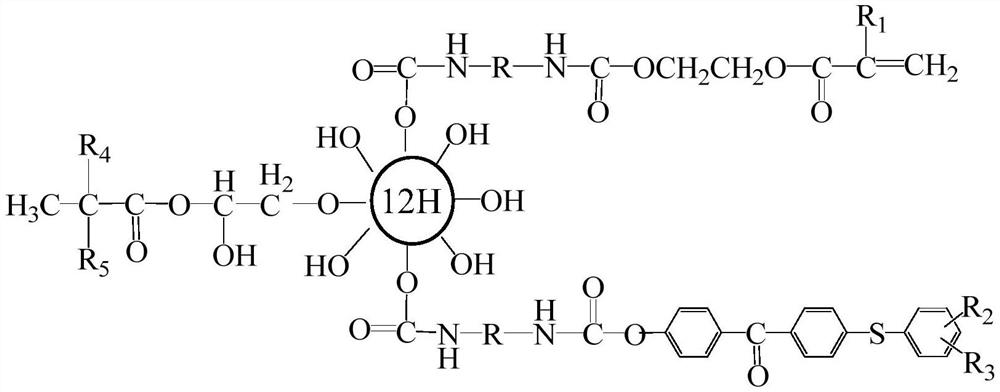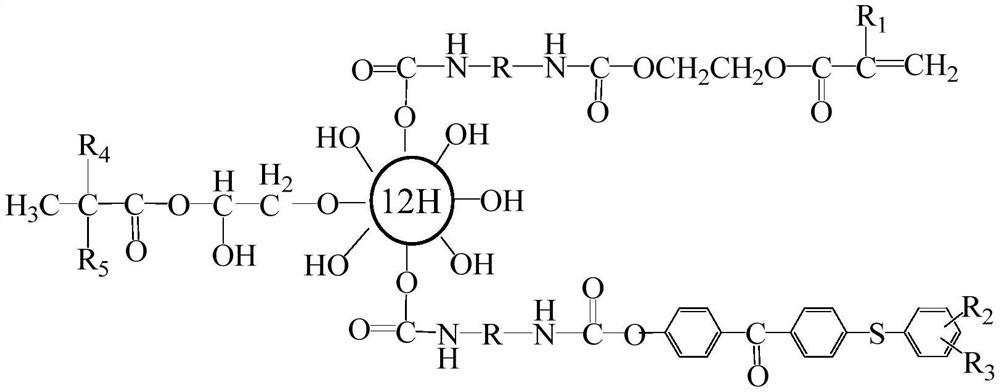Sulfur-containing benzophenone modified hyperbranched self-initiation light-curable resin
A technology of sulfur-containing benzophenone and light-curable resin, which is applied in applications, coatings, inks, etc., can solve the problems of easy yellowing of the cured coating, slow curing rate, and easy migration to the surface, so as to overcome the curing rate Slow, excellent flexibility, high self-initiation efficiency
- Summary
- Abstract
- Description
- Claims
- Application Information
AI Technical Summary
Problems solved by technology
Method used
Image
Examples
Embodiment 1
[0051] Preparation of the second generation of hyperbranched polymer HPB-p, the steps are as follows: by 26.8 parts of trimethylolpropane (TMP), 80.5 parts of 2,2-dimethylolpropionic acid (DMPA), 25.0 parts of xylene, 0.4 Parts of catalyst p-toluenesulfonic acid were added to a four-necked flask equipped with a stirrer, a thermometer, an addition funnel, and a reflux water separator, and heated to 150-170°C under a nitrogen atmosphere for reflux reaction at normal pressure for 4 hours. When the detected acid value was lower than At 25mgKOH / g, add 161.0 parts of 2,2-dimethylolpropionic acid, 0.8 parts of p-toluenesulfonic acid and 30.0 parts of xylene respectively, reflux at 150-170°C for 2 hours, and then reduce the pressure to 1.2KPa Stop the decompression after reacting for 2 hours, and stop the reaction when the detected acid value is lower than 20mgKOH / g; distill the xylene under reduced pressure, add 50.0 parts of acetone after cooling, dissolve completely, add 80.0 parts ...
Embodiment 2
[0053] Preparation of the second generation of hyperbranched polymer HPB-b, the steps are as follows: by 26.8 parts of trimethylolpropane (TMP), 89.7 parts of 2,2-dimethylolbutyric acid (DMBA), 30.0 parts of xylene, 0.45 Parts of catalyst p-toluenesulfonic acid were added to a four-necked flask equipped with a stirrer, a thermometer, an addition funnel and a reflux water separator, heated under nitrogen protection to 105-120°C under normal pressure and refluxed for 4 hours, when the detected acid value was lower than At 25mgKOH / g, add 179.4 parts of 2,2-dimethylolpropionic acid, 0.9 parts of p-toluenesulfonic acid and 40.0 parts of xylene respectively, and react under normal pressure at 140-170°C for 2 hours, and then reduce the pressure to 1.2KPa Stop the decompression after reacting for 2 hours, and stop the reaction when the detected acid value is lower than 20mgKOH / g; evaporate the xylene under reduced pressure, add 80.0 parts of acetone after cooling, dissolve completely, ...
Embodiment 3
[0055] Preparation of isocyanate-acrylic acid functional monomer MDI-HEA: Add 150.0 parts of MDI and 0.08 parts of DBTDL to a four-necked flask equipped with a reflux condenser, a thermometer, a dropping funnel and a stirrer, stir to raise the temperature, and slowly Add dropwise a mixture of 70.0 parts of β-hydroxyethyl acrylate, 0.1 parts of hydroquinone and 50.0 parts of acetone. After the addition is complete, raise the temperature to 45-50°C to continue the reaction for 4 hours, and then take samples every 30 minutes to detect the NCO value of the system , when the detected NCO value is half of the initial value, the reaction is stopped, and the temperature is lowered to 40°C to prepare the isocyanate-acrylic acid functional monomer MDI-HEA.
PUM
 Login to View More
Login to View More Abstract
Description
Claims
Application Information
 Login to View More
Login to View More - R&D
- Intellectual Property
- Life Sciences
- Materials
- Tech Scout
- Unparalleled Data Quality
- Higher Quality Content
- 60% Fewer Hallucinations
Browse by: Latest US Patents, China's latest patents, Technical Efficacy Thesaurus, Application Domain, Technology Topic, Popular Technical Reports.
© 2025 PatSnap. All rights reserved.Legal|Privacy policy|Modern Slavery Act Transparency Statement|Sitemap|About US| Contact US: help@patsnap.com



